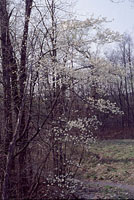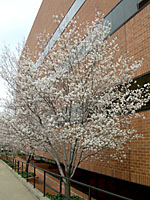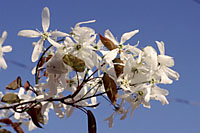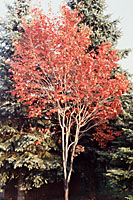Terry L. Ettinger Horticulture Consulting Services
Meeting The Needs Of Today With A Vision For The Future
Recommended Trees -
Serviceberry
 Nearly twenty species of serviceberry (Amelanchier) are native to North America, and at least eight are native
to New York according to the
USDA Natural Resource Conservation Service Plants Database.
Nearly twenty species of serviceberry (Amelanchier) are native to North America, and at least eight are native
to New York according to the
USDA Natural Resource Conservation Service Plants Database.
In the woods and along fencerows throughout Central New York, you’re most likely to find downy serviceberry (A. arborea) and Allegheny serviceberry (A. laevis) coming into bloom during the last week or so in April through the second week or so in May, above. In fact, the two are very similar in appearance and readily hybridize, giving rise to an intermediate hybrid species A. x. grandiflora, or Apple serviceberry.
 So, are you already thoroughly confused? Don’t worry, because they hybridize so readily, their positive identification is often difficult -
even for experts!
So, are you already thoroughly confused? Don’t worry, because they hybridize so readily, their positive identification is often difficult -
even for experts!
What’s most important to remember is that in landscape settings, serviceberry is most often a single, at left, or multiple-stemmed small tree that ultimately grows twenty to twenty five feet tall and spreads to about twenty feet. It’s also adaptable to a wide range of conditions including fairly dry soils as well as those that are occasionally damp to wet during cool weather. And, while it will grow best in full sun, it will survive and grow relatively well in open woodland settings.
 Serviceberries
are smothered by countless clusters of pure white, five-petal flowers that open at the
same time as the purple-tinged leaves begin to expand, at right. Unfortunately, the petals start to drop almost as soon as they open,
resulting in a flower display that lasts barely a week when the
weather is warm and dry.
Serviceberries
are smothered by countless clusters of pure white, five-petal flowers that open at the
same time as the purple-tinged leaves begin to expand, at right. Unfortunately, the petals start to drop almost as soon as they open,
resulting in a flower display that lasts barely a week when the
weather is warm and dry.
 In late June, plants produce clusters of red, blueberry-sized fruit that turn deep purple as they ripen,
left. If you can get
to the fruit before birds do, you’ll find that they’re very similar in taste to blueberries – maybe even a bit sweeter!
In late June, plants produce clusters of red, blueberry-sized fruit that turn deep purple as they ripen,
left. If you can get
to the fruit before birds do, you’ll find that they’re very similar in taste to blueberries – maybe even a bit sweeter!
Finally, in mid- to late September, the leaves of serviceberry turn various shades of yellow, through bright orange to scarlet, depending upon the cultivar, below right. `Autumn Brilliance’ serviceberry, for example, was selected specifically for it’s brilliant red fall foliage color.
 The tree-form cultivars most often available from local garden centers and landscape contractors include
the above-mentioned `Autumn Brilliance,’ as well as `Princess Diana,’ and `Robin Hill.’ All three are similar in size
and ornamental traits and are, therefore, generally interchangeable.
The tree-form cultivars most often available from local garden centers and landscape contractors include
the above-mentioned `Autumn Brilliance,’ as well as `Princess Diana,’ and `Robin Hill.’ All three are similar in size
and ornamental traits and are, therefore, generally interchangeable.
Meanwhile, if you’ve been frustrated in your attempts to grow blueberries, the shrubby saskatoon serviceberry, A. alnifolia, may be worth a try. It grows well in harsh, wind-swept locations and in soils that are quite alkaline – conditions that would do in blueberries in very short order! The online publication, "Growing Saskatoons – A Manual for Orchardists," is certainly your best bet for more information on this unique small fruit!